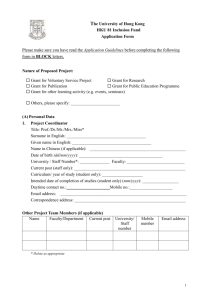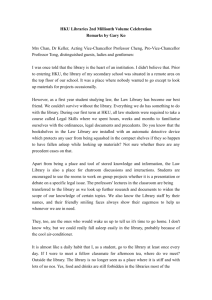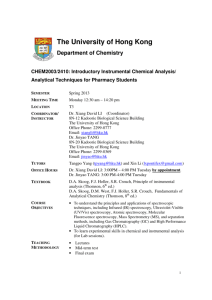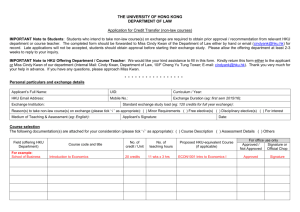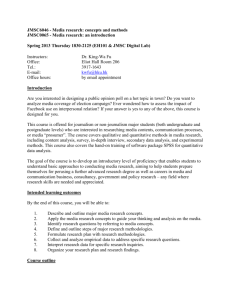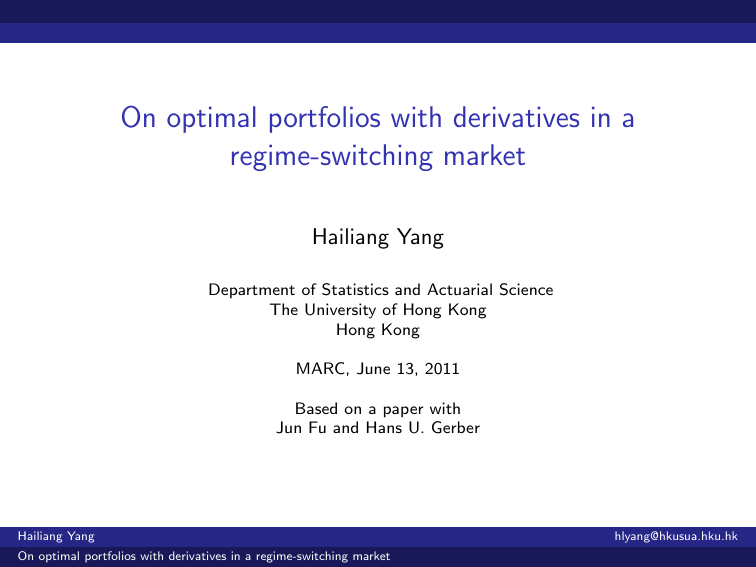
On optimal portfolios with derivatives in a
regime-switching market
Hailiang Yang
Department of Statistics and Actuarial Science
The University of Hong Kong
Hong Kong
MARC, June 13, 2011
Based on a paper with
Jun Fu and Hans U. Gerber
Hailiang Yang
On optimal portfolios with derivatives in a regime-switching market
hlyang@hkusua.hku.hk
Introduction
I
Portfolio selection problem is one of the key topics in finance.
I
This is recent work
I
This topic is one of Marc’s research areas
Hailiang Yang
On optimal portfolios with derivatives in a regime-switching market
hlyang@hkusua.hku.hk
Literature review
I
de Finetti (1940), in the context of choosing optimum
reinsurance levels, Bruno de Finetti essentially proposed
mean-variance analysis with correlated risks.
I
Markowitz’s single-period mean-variance model (1952, 1959)
— tradeoff between return (mean) and risk (variance).
I
Tobin (1958) extends Markowitz’s model to include a risk-free
asset — market portfolio, separation theorem.
I
Samuelson (1969) extended the work of Markowitz to a
multi-period setting. Dynamic programming method was
employed to find the optimal consumption strategy so as to
maximize the overall utility of consumption.
Hailiang Yang
On optimal portfolios with derivatives in a regime-switching market
hlyang@hkusua.hku.hk
Literature review
I
Merton (1969, 1971) extended these work to continuous-time
setting. Ito calculus and the methods of continuous-time
stochastic optimal control were introduced.
I
Cox and Huang (1989, 1991), and Pliska (1986) introduced
the martingale technique to deal with the continuous-time
optimal consumption and investment problem. The problem,
which is dynamic in nature, can be reduced to a static one by
using the martingale representation theorem.
I
Van Weert, Dhaene and Goovaerts, (2010) Optimal portfolio
selection for general provisioning and terminal wealth
problems, Insurance: Mathematics and Economics, vol. 47,
no. 1, pp. 90 - 97.
Hailiang Yang
On optimal portfolios with derivatives in a regime-switching market
hlyang@hkusua.hku.hk
Literature review
I
In the literature, most models contain risky and risk free assets
I
Kraft (2003) considers the optimal portfolio problem with
wealth consisting of stock, option and bond. By introducing
the elasticity of the portfolio with respect to the stock price,
the paper shows that we can use the elasticity as the single
control variable.
Hailiang Yang
On optimal portfolios with derivatives in a regime-switching market
hlyang@hkusua.hku.hk
Literature review
I
Options: Di Masi et al. (1994), Buffington and Elliott (2001),
Guo (2001)
I
Optimal Trading Rules, Optimal Portfolio: Zariphopoulou
(1992), Zhang (2001), Zhou and Yin (2003), Cheung and
Yang (2004)
I
Risk Theory: Asmussen (1989)
Hailiang Yang
On optimal portfolios with derivatives in a regime-switching market
hlyang@hkusua.hku.hk
Portfolio with derivatives
Hailiang Yang
On optimal portfolios with derivatives in a regime-switching market
hlyang@hkusua.hku.hk
Notation
I
Wt :
standard Brownian motion
I
αt : continuous-time stationary Markov chain which takes
values in the regime space M = {1, ..., d} and has a transition
rate matrix Q = (qij ) ∈ R d×d .
I
B(t):
I
St :
risk free bond price
stock price
Hailiang Yang
On optimal portfolios with derivatives in a regime-switching market
hlyang@hkusua.hku.hk
Price dynamics
dB
B
dS
S
= r (t, αt )dt,
= µ(t, αt )dt + σ(t, αt )dWt .
Hailiang Yang
On optimal portfolios with derivatives in a regime-switching market
(1)
hlyang@hkusua.hku.hk
Dynamic for derivatives
dO(t, αt , St ) = Ot (t, αt , St )dt + OS (t, αt , St )dSt
d
+
X
1
qαt k O(t, k, St )dt,
OSS (t, αt , St )(dSt )2 +
2
k=1
(2)
Hailiang Yang
On optimal portfolios with derivatives in a regime-switching market
hlyang@hkusua.hku.hk
The discounted price of derivative V (t, αt , St )
Zt
r (u, αu )du) · O(t, αt , St ).
V (t, αt , St ) = exp(−
(3)
0
V (t, αt , St ) is a martingale.
Vt (t, αt , St ) + VS (t, αt , St )r (t, αt )St
d
X
1
+ VSS (t, αt , St )σ 2 (t, αt )St2 +
qαt k V (t, k, St ) = 0. (4)
2
k=1
From this we have
d
X
1
Ot + OS rS + OSS σ 2 S 2 +
qαt k O(t, k, St ) = rO
2
(5)
k=1
Hailiang Yang
On optimal portfolios with derivatives in a regime-switching market
hlyang@hkusua.hku.hk
I
Here we are not pricing the regime switching risk. That is we
do not change the transaction probability of the Markovian
chain when we obtain the risk neutral probability.
Hailiang Yang
On optimal portfolios with derivatives in a regime-switching market
hlyang@hkusua.hku.hk
We construct a self-financing portfolio which contains short one
option, long OS the underlying stock, the portfolio value is
Π = −O + OS · S,
(6)
from the self-financing property and (2), we have
dΠ = −dO + OS dS
d
X
1
= −Ot dt − OSS σ 2 S 2 dt −
qαt k O(t, k, St )dt, (7)
2
k=1
and (5) leads to
dΠ = −rOdt + OS rSdt
= r (−O + OS S)dt.
(8)
Therefore, Π = −O + OS S is risk free, hence −O + OS · S is a
delta-neutral portfolio.
Hailiang Yang
On optimal portfolios with derivatives in a regime-switching market
hlyang@hkusua.hku.hk
Substituting dΠ = r (−O + OS S)dt into dO = −dΠ + OS dS
results in
dO = −r (−O + OS S)dt + OS dS
= rOdt + OS (µ − r )Sdt + OS σSdW
Hailiang Yang
On optimal portfolios with derivatives in a regime-switching market
(9)
hlyang@hkusua.hku.hk
dO
= [r + εO (µ − r )]dt + εO σdW ,
O
where
εO (t, αt , St ) =
(10)
OS (t, αt , St )St
O(t, αt , St )
is the elasticity of the option price with respect to the stock price
Hailiang Yang
On optimal portfolios with derivatives in a regime-switching market
hlyang@hkusua.hku.hk
For a portfolio of option, stock, and bond of the form
X = χO O + χS S + χB B,
the dynamics of X is
dX = χO dO + χS dS + χB dB,
where χO , χS , and χB denote the number of shares of options,
stocks and bonds respectively and dB = rBdt
Hailiang Yang
On optimal portfolios with derivatives in a regime-switching market
hlyang@hkusua.hku.hk
dX
X
χO dO
χS dS
χB dB
+
+
X
X
X
dO
dS
dB
= xO
+ xS
+ xB
,
O
S
B
=
(11)
where
χS S
χB B
χO O
,
xS =
,
xB =
,
X
X
X
denote the percentages of wealth invested in the three assets and
we have
xO + xS + xB = 1.
xO =
Hailiang Yang
On optimal portfolios with derivatives in a regime-switching market
hlyang@hkusua.hku.hk
dX
X
= [xO (r + εO (µ − r )) + xS µ + xB r ]dt + [xO εO σ + xS σ]dW
= [xO εO (µ − r ) + xS (µ − r ) + r ]dt + [xO εO σ + xS σ]dW
= [r + ε(µ − r )]dt + εσdW
(12)
where, as in Kraft (2003), ε denotes the elasticity of the whole
portfolio with respect to the stock price, i.e.
ε = xO εO + xS ,
(13)
and note that the elasticities of the stock price and bank account
value with respect to the stock price are
εS = 1,
Hailiang Yang
On optimal portfolios with derivatives in a regime-switching market
εB = 0.
hlyang@hkusua.hku.hk
Optimization problem
J(t, αt , , Xt ) = max{E [U(XT )|Ft ]},
ε
s.c.
(14)
dX
= [r + ε(µ − r )]dt + εσdW ,
X
X0 > 0,
XT
≥ 0.
Hailiang Yang
On optimal portfolios with derivatives in a regime-switching market
hlyang@hkusua.hku.hk
Hamilton-Jacobi-Bellman (HJB) optimality condition
max DJ = 0,
(15)
where D is the Dynkin operator and DJ is given by
d
X
1
DJ = Jt + JX [r + ε(µ − r )]X + JXX ε2 σ 2 X 2 +
qαt ,k J(t, k, Xt ),
2
k=1
(16)
where the subscripts denote the partial derivatives of J with
respect to t and x.
Hailiang Yang
On optimal portfolios with derivatives in a regime-switching market
hlyang@hkusua.hku.hk
Optimal elasticity
∂DJ
= JX (µ − r )X + JXX εσ 2 X 2 ,
∂ε
by setting
∂DJ
∂ε
(17)
= 0, we can obtain the optimal elasticity as
ε∗ = −
JX (µ − r )
,
JXX X σ 2
Hailiang Yang
On optimal portfolios with derivatives in a regime-switching market
(18)
hlyang@hkusua.hku.hk
HJB equation
JX (µ − r )2
]
JXX X σ 2
d
X
1
2 JX (µ − r ) 2
+ JXX X [
] +
qαt ,k J(t, k, Xt ) = 0,
2
JXX X σ
Jt + JX X [r −
k=1
Hailiang Yang
On optimal portfolios with derivatives in a regime-switching market
hlyang@hkusua.hku.hk
HJB equation
d
X
1 2
JX (µ − r )2 = JXX σ 2 [Jt + JX Xr +
qαt ,k J(t, k, Xt )],
2
(19)
k=1
with the terminal condition
J(T , αT , XT ) = U(XT ).
Hailiang Yang
On optimal portfolios with derivatives in a regime-switching market
(20)
hlyang@hkusua.hku.hk
CRRA utility
Assuming that the agent has constant relative risk aversion
(CRRA) with utility function given by
U(x) =
xγ
,
γ
where γ < 1 and γ 6= 0
Hailiang Yang
On optimal portfolios with derivatives in a regime-switching market
hlyang@hkusua.hku.hk
Solution
J(t, i, x) = a(t, i)
xγ
,
γ
(21)
where a(·, i) is a continuous function with a(T , i) = 1 for each
i ∈ M. Then, immediately it follows that
xγ
,
γ
JX (t, i, x) = a(t, i)x γ−1 ,
0
Jt (t, i, x) = a (t, i)
JXX (t, i, x) = a(t, i)(γ − 1)x γ−2 .
Hailiang Yang
On optimal portfolios with derivatives in a regime-switching market
hlyang@hkusua.hku.hk
0
λ(t, i)a(t, i) = a (t, i) +
d
X
qi,k a(t, k),
(22)
k=1
where
1 µ(t, i) − r (t, i) 2 γ
λ(t, i) = [
]
− r (t, i)γ.
2
σ(t, i)
γ−1
Hailiang Yang
On optimal portfolios with derivatives in a regime-switching market
hlyang@hkusua.hku.hk
Matrix form
0
(Λ(t) − Q)a(t) = a (t),
(23)
where
λ(t, 1)
Λ(t) =
0
..
.
..
.
···
0
..
.
0
···
..
.
..
.
0
..
.
0
λ(t, d)
0
,
0
a(t) = (a(t, 1), a(t, 2), · · · a(t, d)) ,
0
0
0
0
0
a (t) = (a (t, 1), a (t, 2), · · · a (t, d)) ,
Hailiang Yang
On optimal portfolios with derivatives in a regime-switching market
hlyang@hkusua.hku.hk
Solution
J(t, i, x) = a(t, i)
xγ
,
γ
∀i ∈ M,
where a(t, i) is uniquely determined by (23). Furthermore, due to
(18), we have
ε∗ (t, i) =
µ(t, i) − r (t, i)
.
(1 − γ)σ 2 (t, i)
Hailiang Yang
On optimal portfolios with derivatives in a regime-switching market
(24)
hlyang@hkusua.hku.hk
Solution
For a portfolio of only stock and option with xS + xO = 1, by
tracking this optimal elasticity, the optimal portfolio policy (xS∗ and
xO∗ ) can be obtained through (13). But if an agent also invests in
the bank account beyond the stock and option, the processes (xS∗ ,
xO∗ and xB∗ ) cannot be determined uniquely.
Hailiang Yang
On optimal portfolios with derivatives in a regime-switching market
hlyang@hkusua.hku.hk
According to (24) where γ < 1 and γ 6= 0, we find that the smaller
is γ, the smaller is the elasticity of the portfolio. This is consistent
with the definition of Arrow-Pratt index of risk aversion
−
xU ” (x)
= 1 − γ,
U 0 (x)
(25)
which indicates higher level of risk aversion for smaller value of γ.
Hailiang Yang
On optimal portfolios with derivatives in a regime-switching market
hlyang@hkusua.hku.hk
CARA utility
1
U(x) = − e −γx ,
γ
where γ > 0. Similarly, we conjecture that the solution to (19) and
(20) is given by
1
J(t, i, x) = − exp[−γg (t, i)x]a(t, i),
γ
(26)
where a(·, i) and g (·, i) are continuous functions and
a(T , i) = g (T , i) = 1 for each i ∈ M.
Hailiang Yang
On optimal portfolios with derivatives in a regime-switching market
hlyang@hkusua.hku.hk
CARA utility
0
g (t, i) + g (t, i)r (t, i) = 0,
0
d
J(t, k, x)
a (t, i) X
+
qi,k
a(t, i)
J(t, i, x)
=
k=1
(27)
1 µ(t, i) − r (t, i) 2
(
) ,
2
σ(t, i)
(28)
r (s, i)ds).
(29)
and the terminal conditions imply that
Z
g (t, i) = exp(
T
t
Hailiang Yang
On optimal portfolios with derivatives in a regime-switching market
hlyang@hkusua.hku.hk
CARA utility
If the interest rate is independent of the state of the Markovian
chain,
0
d
a (t, i) X
a(t, k)
1 µ(t, i) − r (t) 2
+
qi,k
= (
) ,
a(t, i)
a(t, i)
2
σ(t, i)
k=1
and similar to what we have done for CRRA utility, it follows that
0
(Λ(t) − Q)a(t) = a (t)
Hailiang Yang
On optimal portfolios with derivatives in a regime-switching market
(30)
hlyang@hkusua.hku.hk
CARA utility
1 µ(t, i) − r (t) 2
[
] ,
2
σ(t, i)
λ(t, 1) 0 · · ·
..
..
.
.
0
Λ(t) =
..
..
..
.
.
.
0
··· 0
λ(t, i) =
0
..
.
0
λ(t, d)
,
a(t) = (a(t, 1), a(t, 2), · · · a(t, d),
0
a(t)
0
= (a(t, 1), a(t, 2), · · · a(t, d)) ,
and a(T ) = 1.
Hailiang Yang
On optimal portfolios with derivatives in a regime-switching market
hlyang@hkusua.hku.hk
Solution
1
J(t, i, x) = − exp[−γg (t)x]a(t, i),
γ
∀i ∈ M.
By substituting this result into (18), we have
ε∗ (t, i) =
µ(t, i) − r (t)
.
γg (t)xσ 2 (t, i)
Hailiang Yang
On optimal portfolios with derivatives in a regime-switching market
(31)
hlyang@hkusua.hku.hk
In contrast to CRRA utility, for smaller value of γ, the Arrow-Pratt
index of risk aversion for CARA utility given by
−
xU ” (x)
= γx
U 0 (x)
(32)
indicates lower level of risk aversion, and (31) implies higher
elasticity of portfolio which is more sensitive to the changes in the
stock price.
Hailiang Yang
On optimal portfolios with derivatives in a regime-switching market
hlyang@hkusua.hku.hk
Analyzing the optimal portfolio: Without risk free asset
For the portfolio containing only stock and option, we have
xS∗ + xO∗
xS∗
+
xO∗ εO
= 1,
= ε∗ ,
and these two equations imply that
xS∗ = −
JX (µ − r ) 1
εO
−
.
2
JXX X σ 1 − εO
1 − εO
Hailiang Yang
On optimal portfolios with derivatives in a regime-switching market
(33)
hlyang@hkusua.hku.hk
Analyzing the optimal portfolio: Without risk free asset
I
)
− JJX (µ−r
:
X σ2
I
) 1
:
− JJX (µ−r
X σ 2 1−εO
I
− 1−εO :
XX
XX
εO
optimal strategy in Merton’s model
the modified term of speculation
the pure delta neutral hedging term
Hailiang Yang
On optimal portfolios with derivatives in a regime-switching market
hlyang@hkusua.hku.hk
Analyzing the optimal portfolio: Without risk free asset
X = χO O + χS S,
to make it delta-neutral, we require that
χO OS + χS = 0,
and equivalently,
xS = −xO OS
S
= −xO εO ,
O
(34)
which, combined with xS + xO = 1, results in
xS = −
εO
.
1 − εO
Hailiang Yang
On optimal portfolios with derivatives in a regime-switching market
hlyang@hkusua.hku.hk
Effect of γ
We use the CRRA utility function, which, due to (21), admits
−
JX (µ − r )
JXX X σ 2
=
xS∗ =
µ−r
,
(1 − γ)σ 2
1
εO
µ−r
−
,
(1 − γ)σ 2 1 − εO
1 − εO
(35)
(36)
where γ < 1, γ 6= 0.
Hailiang Yang
On optimal portfolios with derivatives in a regime-switching market
hlyang@hkusua.hku.hk
Observations
Same as the optimal solution of the Merton’s problem, for the
reduced portfolio optimization problem, the smaller is γ, the more
risk-averse is the agent as indicated by the Arrow-Pratt index of
risk aversion, so the less is its wealth invested in stock and the
more is invested in the bank account.
Hailiang Yang
On optimal portfolios with derivatives in a regime-switching market
hlyang@hkusua.hku.hk
Observations
As γ decreases, the modified term of speculation in xS∗ approaches
zero and xS∗ converges to the term of pure delta neutral hedging.
Hailiang Yang
On optimal portfolios with derivatives in a regime-switching market
hlyang@hkusua.hku.hk
Discrete-Time Model with Regime Switching
Based on a paper with K.C. Cheung:
K. C. Cheung and H. Yang, “Asset Allocation with
Regime-Switching: Discrete-Time Case”, ASTIN Bulletin, Vol. 34,
No. 1, 99-111, 2004.
Hailiang Yang
On optimal portfolios with derivatives in a regime-switching market
hlyang@hkusua.hku.hk
Discrete-Time Model with Regime Switching
I
Discrete-time setting: investor can decide the level of
consumption, cn at time n = 0, 1, 2, . . . , T − 1
I
After consumption, all the remaining money will be invested
in a risky asset
I
The random return of the risky asset in different time periods
will depend on the credit ranking which is modeled by a
time-homogeneous Markov chain {ξn }0≤n≤T with state space
M = {1, 2, . . . , M} and transition probability matrix P = (pij )
Hailiang Yang
On optimal portfolios with derivatives in a regime-switching market
hlyang@hkusua.hku.hk
Absorption State — Default Risk
I
Assume that state M of the Markov Chain is an absorbing
state:
pMj
= 0
pMM
= 1.
j = 1, 2, . . . , M − 1,
I
Default occurs at time n if ξn = M. In this case, the investor
can only receive a fraction, δ, of the amount that he/she
should have received.
I
The recovery rate δ, is a random variable, valued in [0, 1]
Hailiang Yang
On optimal portfolios with derivatives in a regime-switching market
hlyang@hkusua.hku.hk
Wealth Process
I
{Wn }0≤n≤T : wealth process of the investor
Wn+1 =
(Wn − cn )Rnξn (1{ξn+1 6=M} + δ1{ξn+1 =M} )
W n − cn
if ξn 6= M,
if ξn = M,
n = 0, 1, . . . , T − 1, where 1{··· } is the indicator function.
I
Rni is the return of the risky asset in the time period [n, n + 1],
given that the Markov chain is at regime i at time n.
Hailiang Yang
On optimal portfolios with derivatives in a regime-switching market
hlyang@hkusua.hku.hk
Assumptions
I
I
I
The random returns R0i , R1i , . . . , RTi −1 are i.i.d. with
distribution Fi ; they are assumed to be strictly positive and
integrable
j
Rni is independent of Rm
, for all m 6= n
The Markov chain {ξ} is stochastically independent of the
random returns in the following sense:
P(ξn+1 = in+1 , Rnin ∈ B | ξ0 = i0 , . . . , ξn = in ) = pin in+1 P(Rnin ∈ B)
for all i0 , . . . , in , in+1 ∈ S, B ∈ B(R) and n = 0, 1, . . . , T − 1
Hailiang Yang
On optimal portfolios with derivatives in a regime-switching market
hlyang@hkusua.hku.hk
Assumptions
I
0 ≤ cn ≤ Wn (Budget constraint)
I
The recovery rate δ is stochastically independent of all other
random variables
Hailiang Yang
On optimal portfolios with derivatives in a regime-switching market
hlyang@hkusua.hku.hk
I
Given that the initial wealth is W0 and the initial regime is
i0 ∈ M∗ := M \ {M}, the objective of the investor is to
#
" T
X1
(cn )γ
max E0
γ
{c0 ,...,cT }
n=0
over all admissible consumption strategies. Here 0 < γ < 1.
I
Admissible consumption strategy: a feedback law
cn = cn (ξn , Wn ) satisfying the budget constraint
I
Optimal Consumption Strategy: Ĉ = {cˆ0 , . . . , cˆT }
Hailiang Yang
On optimal portfolios with derivatives in a regime-switching market
hlyang@hkusua.hku.hk
I
For n = 0, 1, . . . , T , the value function Vn (ξn , Wn ) is defined
as
#
" T
X1
γ
Vn (ξn , Wn ) =
max
En
(ck ) .
γ
{cn ,cn+1 ,...,cT }
k=n
I
Bellman’s
Equation:
V
(ξ
,
W
n n n ) = max0≤cn ≤Wn En [U(cn ) + Vn+1 (ξn+1 , Wn+1 )]
n = 0, 1, . . . , T −
γ
1
VT (ξT , WT ) = γ WT
Hailiang Yang
On optimal portfolios with derivatives in a regime-switching market
hlyang@hkusua.hku.hk
I
Suppose λ > 0, w > 0, and 0 < γ < 1 are fixed constants.
The function f : [ 0, w ] → R defined by
f (c) = c γ + λ(w − c)γ
(37)
will achieve its unique maximum at
w
ĉ =
(38)
1
1 + λ 1−γ
and the maximum value is given by
1
f (ĉ) = w γ (1 + λ 1−γ )1−γ .
Hailiang Yang
On optimal portfolios with derivatives in a regime-switching market
(39)
hlyang@hkusua.hku.hk
I
Define some symbols recursively:
1
i ∈ M∗ ,
H (i) = {E[(R i )γ ]} 1−γ ,
(i)
L0
(i)
Ln
(i)
K1
(i)
Kn
i ∈ M,
= 0,
=
(i)
H (i) Kn 1{i6=M}
+ n1{i=M} ,
i ∈ M, n = 1, 2, . . . , T ,
1
1−γ
= [1 − piM + piM E(δ γ )] ,
i ∈ M∗ ,
1
M−1
1−γ
X
(j) 1−γ
(M) 1−γ
γ
,
=
pij (1 + Ln−1 )
+ piM E(δ )(1 + Ln−1 )
j=1
i ∈ M∗ , n = 2, . . . , T .
I
(M)
Note that K· ’s are not defined. M (i) is well-defined since
we have assumed that R i is integrable.
Hailiang Yang
On optimal portfolios with derivatives in a regime-switching market
hlyang@hkusua.hku.hk
I
For n = 0, 1, . . . , T , the value function is given by
VT −n (i, w ) =
1 γ
(i)
w (1 + Ln )1−γ ,
γ
(40)
and the optimal consumption strategy is given by
(i)
ĉT −n (i, w ) = w (1 + Ln )−1 .
Hailiang Yang
On optimal portfolios with derivatives in a regime-switching market
(41)
hlyang@hkusua.hku.hk
I
From this result, we see that if we are now at time T − n, and
in regime i, then we should consume a fraction of our wealth
which is equal to
1
.
(n)
1 + Li
Thus our optimal consumption strategy depends heavily on
the current regime and the remaining investment time
through the function L.
Hailiang Yang
On optimal portfolios with derivatives in a regime-switching market
hlyang@hkusua.hku.hk
I
(·)
For each i ∈ M, Li
is increasing in n:
(i)
(i)
(i)
0 = L0 ≤ L1 ≤ . . . ≤ LT .
I
(·)
For each i ∈ M∗ , Ki
(42)
is increasing in n:
(i)
(i)
(i)
0 ≤ K1 ≤ K2 ≤ . . . ≤ KT .
Hailiang Yang
On optimal portfolios with derivatives in a regime-switching market
(43)
hlyang@hkusua.hku.hk
I
The monotonicity of L implies at the same regime, we should
consume a larger fraction of our wealth when we are closer to
the maturity.
I
This strategy is quite reasonable. If we are closer to the
maturity, a short-term fluctuation in the return of the risky
asset will bring a loss to us that we may not have enough time
to cover. Therefore, we should consume more and invest less.
Hailiang Yang
On optimal portfolios with derivatives in a regime-switching market
hlyang@hkusua.hku.hk
I
For any fixed i ∈ M and w > 0,
ĉ1 (i, w ) ≤ ĉ2 (i, w ) ≤ . . . ≤ ĉT (i, w ).
Hailiang Yang
On optimal portfolios with derivatives in a regime-switching market
hlyang@hkusua.hku.hk
Next, we may guess that at any time period, say T − n, if we are at
a “better” regime, then we should consume less and invest more.
We need two ingredients:
1. A criterion to compare the distributions of the returns in
different regimes =⇒ second order stochastic dominance
2. Market has to “regular” enough =⇒ stochastically
monotone transition matrix
Hailiang Yang
On optimal portfolios with derivatives in a regime-switching market
hlyang@hkusua.hku.hk
Insurance: Mathematics and Economics 31 (2002) 3–33
Review
The concept of comonotonicity in actuarial
science and finance: theory
J. Dhaene, M. Denuit, M.J. Goovaerts, R. Kaas, D. Vyncke∗
DTEW, K.U. Leuven, Naamsestraat 69, 3000 Leuven, Belgium
Received December 2001; accepted 6 June 2002
Abstract
In an insurance context, one is often interested in the distribution function of a sum of random variables. Such a sum
appears when considering the aggregate claims of an insurance portfolio over a certain reference period. It also appears when
considering discounted payments related to a single policy or a portfolio at different future points in time. The assumption
of mutual independence between the components of the sum is very convenient from a computational point of view, but
sometimes not realistic. We will determine approximations for sums of random variables, when the distributions of the terms
are known, but the stochastic dependence structure between them is unknown or too cumbersome to work with. In this paper,
the theoretical aspects are considered. Applications of this theory are considered in a subsequent paper. Both papers are to a
large extent an overview of recent research results obtained by the authors, but also new theoretical and practical results are
presented.
© 2002 Elsevier Science B.V. All rights reserved.
Keywords: Comonotonicity; Actuarial science and finance; Sums of random variables
1. Introduction
In traditional risk theory, the individual risks of a portfolio are usually assumed to be mutually independent.
Standard techniques for determining the distribution function of aggregate claims, such as Panjer’s recursion, De
Pril’s recursion, convolution or moment-based approximations, are based on the independence assumption. Insurance is based on the fact that by increasing the number of insured risks, which are assumed to be mutually
independent and identically distributed, the average risk gets more and more predictable because of the Law of
Large Numbers. This is because a loss on one policy might be compensated by more favorable results on others.
The other well-known fundamental law of statistics, the Central Limit Theorem, states that under the assumption
of mutual independence, the aggregate claims of the portfolio will be approximately normally distributed, provided
the number of insured risks is large enough. Assuming independence is very convenient since the mathematics
for dependent risks are less tractable, and also because, in general, the statistics gathered by the insurer only give
∗
Corresponding author.
E-mail address: david.vyncke@econ.kuleuven.ac.be (D. Vyncke).
0167-6687/02/$ – see front matter © 2002 Elsevier Science B.V. All rights reserved.
PII: S 0 1 6 7 - 6 6 8 7 ( 0 2 ) 0 0 1 3 4 - 8
Compound binomial model
I
Suppose X and Y are two random variables. If
E[g (X )] ≤ E[g (Y )]
I
for any increasing and concave function g such that the
expectations exist, then we say X is dominated by Y in the
sense of second order stochastic dominance and it is denoted
by X ≤SSD Y .
Suppose P = (pij ) is an m × m stochastic matrix. It is called
stochastically monotone if
m
X
pil ≤
l=k
m
X
pjl
l=k
for all 1 ≤ i < j ≤ m and k = 1, 2, . . . , m.
Hailiang Yang
On optimal portfolios with derivatives in a regime-switching market
hlyang@hkusua.hku.hk
Suppose P is a M × M matrix. Let ek = (1, . . . , 1, 0, . . . , 0)0 (i.e.
first k coordinates are 1, the rest are 0) for k = 1, 2, . . . , M. Let
DM = {(x1 , . . . , xM )0 ∈ RM | x1 ≥ · · · ≥ xM } and
PD = {y ∈ DM | Py ∈ DM }.
Suppose that P is an M × M stochastic matrix. The following
statements are equivalent:
1. P is stochastically monotone;
2. PD = DM ;
3. ek ∈ PD for all k = 1, 2, . . . , M.
Hailiang Yang
On optimal portfolios with derivatives in a regime-switching market
hlyang@hkusua.hku.hk
Suppose that the transition probability matrix P is stochastically
monotone. Assume that
R 1 ≥SSD R 2 ≥ · · · ≥SSD R M−1 ,
(44)
and
(i)
H (i) K1 ≥ 1
∀i ∈ M∗ .
(45)
Then we have for n = 1, 2, . . . , T ,
(1)
(2)
(M−1)
Ln ≥ Ln ≥ · · · ≥ Ln
(M)
≥ Ln ,
(46)
and
(1)
Kn
(2)
≥ Kn
(M−1)
≥ · · · ≥ Kn
Hailiang Yang
On optimal portfolios with derivatives in a regime-switching market
.
(47)
hlyang@hkusua.hku.hk
Meaning of R 1 ≥SSD · · · ≥SSD R M−1
Preference of investor: increasing and concave utility function
+
Return of the risky asset in regime i: R i
+
Definition of SSD order
⇓
The M − 1 regimes are ranked according to their
favorability to the risk-averse investor:
regime 1 is the most favorable, regime M − 1 is the most unfavorable
Hailiang Yang
On optimal portfolios with derivatives in a regime-switching market
hlyang@hkusua.hku.hk
Meaning of P being stochastically monotone:
For 1P≤ i < j ≤ M − 1 (regime i is more favorable to regime j)
• M
l=k pil is the probability of switching to the worst M − k + 1
regimes
PMfrom regime i
• l=k pjl is the probability of switching to the worst M − k + 1
regimes from regime j
Intuitively, if the market is “regular” enough, we should have
M
X
pil ≤
l=k
M
X
pjl
l=k
for all possible k. This precisely means that P is stochastically
monotone.
Hailiang Yang
On optimal portfolios with derivatives in a regime-switching market
hlyang@hkusua.hku.hk

